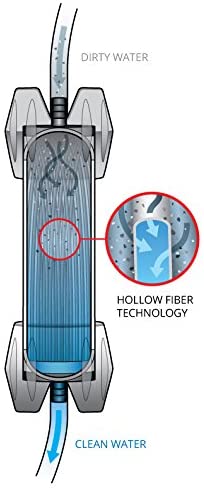Knowing how to backflush and clean your gravity water filter system is important for two key reasons:
- It helps you maintain access to safe drinking water while backcountry camping
- It helps extend the life of your gravity water filter
By far the two most popular gravity water filters are the MSR AutoFlow and Platypus GravityWorks. They are “passive” systems that are lightweight, simple to use, and reliable.
But, since they don’t come cheap, it’s important to clean and maintain them properly before, during and after each camping trip.
Article Contents:
- Gravity Filter Anatomy
- How Long Does a Gravity Filter Last?
- What’s the Difference Between Backflushing and Cleaning?
- Benefits of Backflushing
- How Often Should You Backflush a Gravity Filter?
- Benefits of Cleaning
- How Often Should You Clean a Gravity Filter?
- Step-by-Step Backflushing Instructions
- Step-By-Step Cleaning Instructions
Gravity Water Filter Anatomy

Gravity water filtration systems are incredibly simple to use and understand.
Gravity filtration rely on two principles – hydrostatic head, or the vertical height of a column of water that produces pressure at the base, and microfiltration.
Essentially, water stored in a reservoir positioned higher than the filter flows down via the force of gravity and through the filter cartridge which is filled with microfiltration media.
Typically, microfiltration media have an effective pore size of 0.2 microns that allows the flow of water but traps larger particles and micro-organisms.
Microfiltration vs. Purification
Gravity water filters are classified as “microfilters”, which are vastly different from water “purifiers”. The classification difference boils down to how well the system removes pathogens (i.e., protozoa, bacteria and viruses) from the water.
Generally, microfilters rely on a physical process to remove pathogens, whereas purifiers rely on both a physical AND chemical process to remove and inactivate pathogens.
According to the EPA Guide Standard for Testing Microbiological Water Purifiers:
- A microfilter must “remove 99.9% of protozoa and remove 99.9999% of bacteria”.
- A water purifier must “remove 99.9% of protozoa, remove 99.9999% of bacteria, and inactivate 99.99% of viruses”.
Pro-tip: For a comprehensive guide on drinking water while camping, check out How to Make Water Safe to Drink for Camping.
How Long Does a Gravity Filter Last?
There are two key factors that influence how long a gravity filter will last before it needs to be replaced – the total volume of water that has been filtered and the water turbidity.
Overtime, a filter will eventual fill with microscopic debris which clogs the filter media. High turbidity water sources accelerate the clogging process.
And, no matter how much you backflush and attempt to clean it, the filter just can’t perform at the same level and will need to be replaced.
Cartridge Life Comparison
The primary component in a gravity water filter system that needs to be replaced over time is the filter cartridge.
Water filter manufacturers typically specify how much water each filter cartridge can treat before they need to be replaced.
The filter cartridge life expectancy for the MSR AutoFlow and Platypus GravityWorks is 1500 liters (400 gallons). However, the influence of turbidity can reduce the useful cartridge life down to 1000 to 1200 liters (260 to 320 gallons).
What’s the Difference Between Backflushing and Cleaning a Water Filter?

When it comes to gravity water filters, they don’t need much in terms of maintenance to keep them running at peak performance. After all, they are passive systems with no moving parts.
So, is it absolutely essential that you periodically backflush and routinely clean your gravity water filter?
Yes, absolutely!
Benefits of Backflushing
As previously mentioned, overtime, water turbidity and microscopic particles clog up the microfiltration media. This drastically decreases how fast the filter is able to process water.
- Under prestine cartridge conditions, both the MSR AutoFlow and Platypus GravityWorks can filter 1.75 L/min.
But, with every scoop of unfiltered water into the reservoir, more and more particles start to collect and buildup in the filter. And soon enough, you’ll notice a stark decline in the flow rate of water coming out the clean end.
Backflushing gravity filter essentially purges the filter catridge solids, and allows the water flow to return to normal. Backflushing relies on the same principles of hydrostatic head and pressure, just in the opposite direction.
How Often Should You Backflush a Gravity Filter?
A key metric to monitor and indicate when you should conduct a backflush is the filtered water flow rate.
Just connect a water bottle to the filter and time how long it takes to fill. Divide the water bottle volume once filled by the measured time.
- If the flow dips below 1 L/min it’s time to do a backflush.
Otherwise, regularly backflush after every 8 liters of filtered water, and more often if the water is cloudy or darker-coloured.
Benefits of Cleaning
From a hygienic perspective, cleaning your gravity water filter periodically helps to eliminate the potential for bacteria, mold, and mildew growth.
Cleaning involves the use of chemical additives that kills microorganisms. A common household chemical such as bleach, which contains chlorine, can be mixed with water and used as a cleaning agent.
The disinfection process happens at the microscopic level where chlorine reacts with molecules in the pathogen cell to destroy the organism [Reference]. It’s simple yet very effective.

How Often Should You Clean a Gravity Filter?
Cleaning a gravity filter is slightly more energy intensive and time consuming compared to backflushing, but is nowhere near as often.
Typically, a gravity filter should be cleaned and disinfected before or after long-term storage, or after extended use (e.g., over 10 days of consecutive use).
Pro-tip: Never use a dish washer, microwave or boiling water to disinfect a gravity water filter system. High temperatures can damage or melt parts.
Step-By-Step Backflushing Instructions
To backflush a gravity water filter cartridge, simply:
- Collect at least 0.5 liters of filtered water in a clean water container, either a clean water reservoir or bottle.
- Attach the clean water container to the end of the outlet hose, using an adapter if necessary.
- Remove the hose connection from the unfiltered water container.
- Raise the clean water container above the filter cartridge and allow water to flow in the opposite direction to normal flow (opposite to flow direction indicated on cartridge).
- Allow all clean water to flow back through the filter.
Step-By-Step Cleaning Instructions
To clean and disinfect a gravity water filter cartridge:
- Remove the dirty water reservoir from the hosing.
- Thoroughly rinse the dirty water reservoir with clean water, removing sand and debris from the pre-filter.
- Fill dirty water reservoir with clean tap water. Add 2 drops of bleach for every 1 liter of clean water.
- Reconnect dirty water reservoir with cleaning solution to filter cartridge hosing. Close flow shut-off clamp.
- Hang dirty reservoir above cartridge filter and place outlet hose in sink.
- Open flow shut-off clamp to allow cleaning solution to pass through filter cartridge and drain into sink.
- Air or towel dry gravity water filter system and pack for storage.
Pro-tip: It is not essential that the inside of the filter cartridge dries completely. The bleach solution protects and prevents against the growth of pathogens.
This article contains affiliate links, which help support this blog at no cost to you!

I did the backwashing process but my autoflow filter remained plugged. I took the filter caps off and blew pressurized water through the filter. This seemed to help. Not sure if this is suggested.
Also the fine mesh in the reservoir seemed to be dirty and there is no easy way to get in there to clean it. Is the plug removable? I used an air compressor and then scrubbed with a tooth brush.
Hi Tanya, before doing the backflush, was the flow in the filtering direction extremely low? That would suggest the filter is fairly clogged with particulates and it might be difficult to clear everything out. I’v had the same issue before, and had to blow the water (using my mouth and the tubing) in the reverse direction to help push out the solids.
Also, cleaning the reservoir mesh can be a bit tricky, so using a toothbrush or a pipe cleaner is your best bet.Just don’t use too much force as it might damage the pre-filter.
I plan on making a how-to video detailing the backflushing and cleaning processes over the winter. Stay tuned!